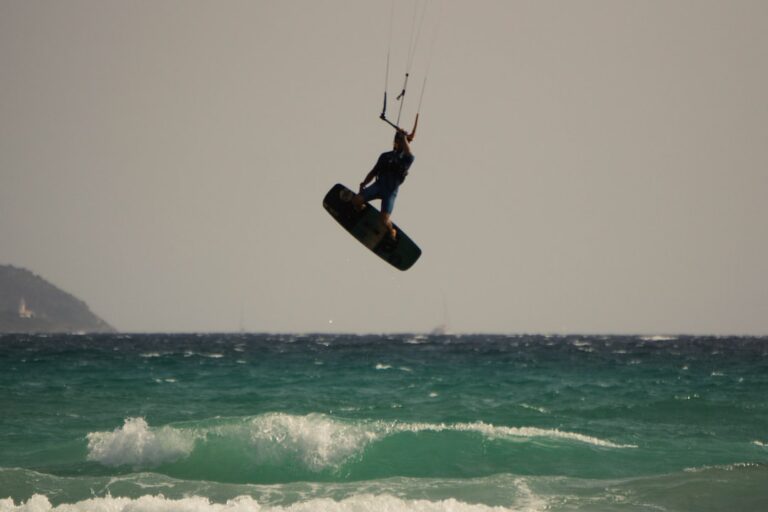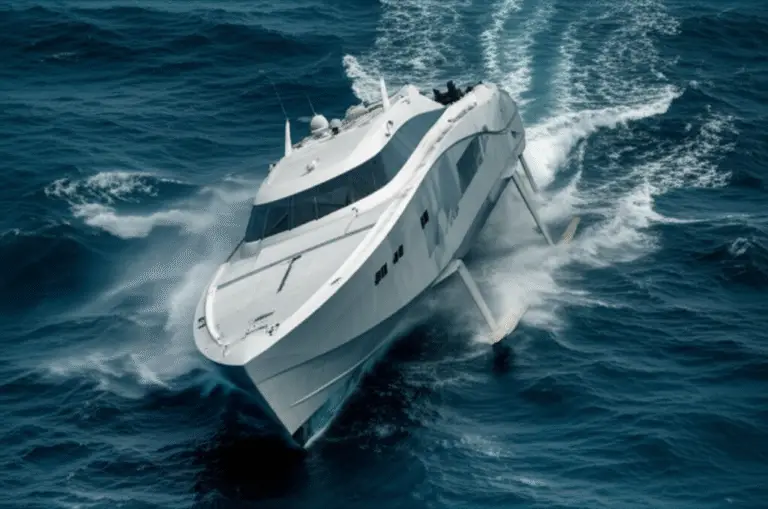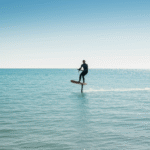Support our hydrofoil educational content for free when you purchase through links on our site. Learn more
8 Essential Safety Precautions When Hydrofoiling Behind a Boat 🚤 (2025)
Picture this: you’re gliding effortlessly above the water, the boat’s wake propelling you forward, wind in your hair, and the hydrofoil humming beneath your feet. Sounds like a dream, right? But before you take that exhilarating plunge, there’s one thing every hydrofoiler must master—safety. Did you know that wearing the right gear can reduce water sport injuries by up to 80%? At Hydrofoiling™, we’ve seen firsthand how a little preparation transforms a risky ride into an unforgettable adventure.
In this comprehensive guide, we’ll walk you through the 8 essential safety precautions you need to know before hydrofoiling behind a boat. From choosing the perfect life jacket and helmet to understanding your role as a rider and captain, we cover everything to keep you safe and stoked. Ready to ride the waves with confidence? Let’s dive in!
Key Takeaways
- Always wear certified safety gear: a high-quality life jacket and helmet are non-negotiable.
- Choose the right boat and equipment: power and wake quality matter for a smooth, safe ride.
- Clear communication between rider and captain is crucial for accident-free hydrofoiling.
- Master your control and awareness on the hydrofoil to avoid common hazards.
- Understand water and weather conditions to pick the safest times to ride.
- Practice emergency procedures and keep a first aid kit handy.
- Invest in training and lessons to build skills and confidence safely.
Ready to gear up? Check out top-rated options like the O’Neill Life Jacket and Troy Lee Designs Helmet to start your safe hydrofoiling journey!
Table of Contents
- Quick Tips and Facts ⚡
- Hydrofoiling Behind a Boat: A Splash of History and Safety Evolution 🌊
- 1. Essential Safety Gear for Hydrofoiling Behind a Boat 🦺
- 2. Choosing the Right Boat and Equipment for Safe Hydrofoiling 🚤
- 3. The Captain’s Role: Navigating Safety and Communication on the Water 🧑✈️
- 4. The Rider’s Responsibilities: Mastering Control and Awareness on the Hydrofoil 🏄♂️
- 5. Understanding Water Conditions and Weather for Hydrofoiling Safety 🌦️
- 6. Common Hazards and How to Avoid Them When Hydrofoiling Behind a Boat ⚠️
- 7. Emergency Procedures and First Aid Tips for Hydrofoiling Incidents 🚑
- 8. Training and Practice: Building Confidence and Competence Safely 🏆
- You’re Ready for Safe Hydrofoiling Adventures! 🌟
- Click to Learn More: Advanced Hydrofoiling Safety Resources and Communities 📚
- Conclusion: Ride the Waves Safely and Confidently! 🌈
- Recommended Links for Hydrofoiling Safety and Gear 🛠️
- FAQ: Your Burning Questions About Hydrofoiling Safety Answered 🔥
- Reference Links and Trusted Sources for Hydrofoiling Safety 📖
Quick Tips and Facts
Learn more about hydrofoiling behind a boat at https://www.hydrofoiling.org/hydrofoiling-behind-a-boat/.
As enthusiasts of hydrofoil boarding at Hydrofoiling™, we’ve compiled a list of essential safety precautions to consider when hydrofoiling behind a boat:
- Always wear a life jacket and a helmet to ensure your safety in case of a fall.
- Choose a suitable boat with a powerful engine to create a smooth wake.
- Make sure the rope attachment point is secure and suitable for hydrofoiling.
- The captain’s role is crucial in maintaining safety and communication on the water.
- As a rider, it’s essential to master control and awareness on the hydrofoil.
Key Statistics
According to the United States Coast Guard, wearing a life jacket can reduce the risk of drowning by up to 80%. Additionally, a study by the National Safety Council found that the majority of water sports-related injuries occur due to lack of proper safety equipment.
Hydrofoiling Behind a Boat: A Splash of History and Safety Evolution
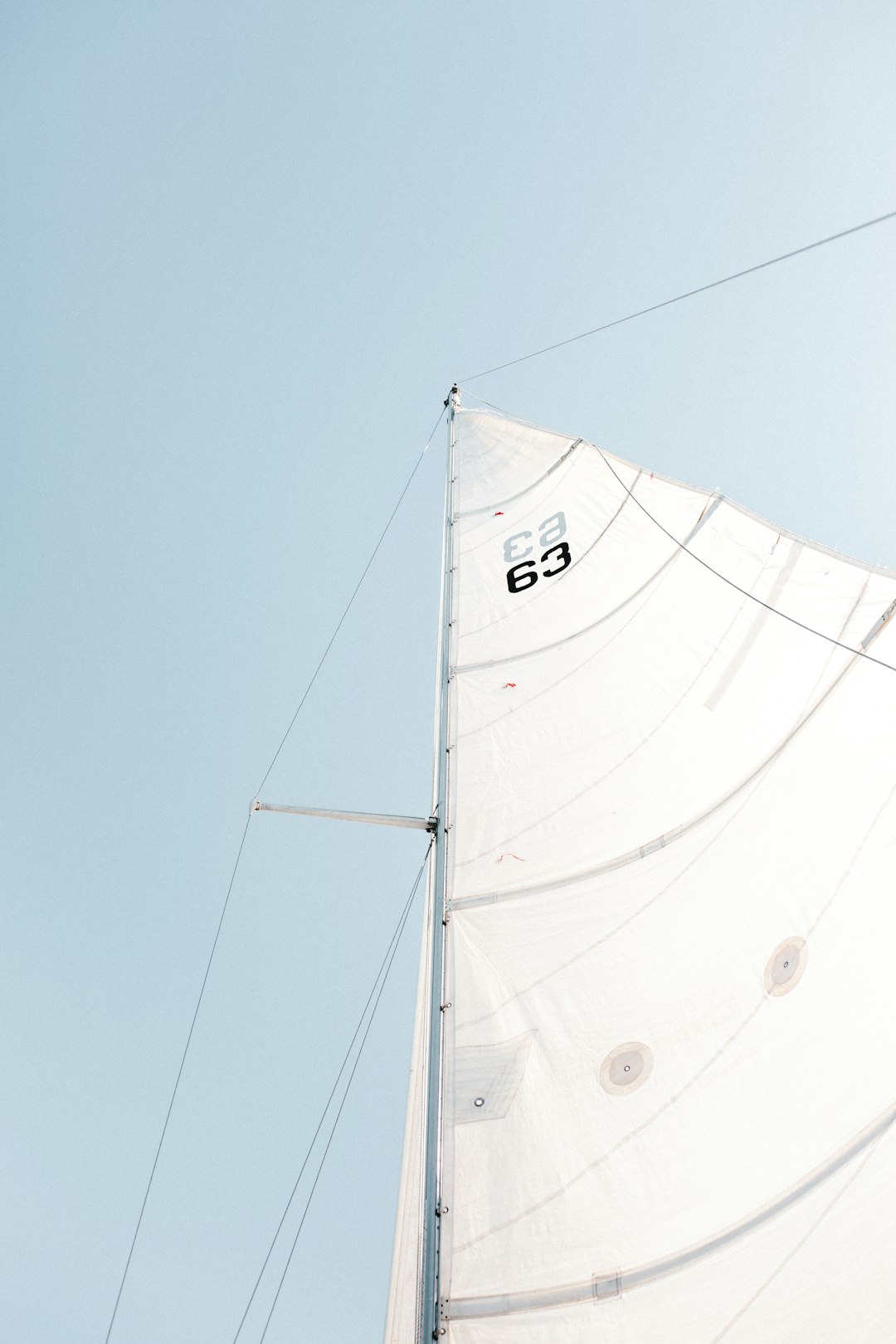
Hydrofoiling has a rich history, dating back to the early 20th century. The first hydrofoil boat was invented by Enrico Forlanini in 1906. Since then, hydrofoiling has evolved significantly, with advancements in technology and safety equipment. Today, hydrofoiling behind a boat is a popular water sport, with many enthusiasts around the world.
Evolution of Safety Equipment
The development of safety equipment has played a crucial role in the evolution of hydrofoiling. From life jackets to helmets, safety gear has become more advanced and effective. For example, modern life jackets are designed to be more comfortable and buoyant, while helmets are equipped with advanced impact protection.
1. Essential Safety Gear for Hydrofoiling Behind a Boat
When it comes to hydrofoiling behind a boat, having the right safety gear is essential. Here’s a rating table for some of the most popular safety gear:
| Safety Gear | Rating (1-10) | Description |
|---|---|---|
| Life Jacket | 9 | Essential for staying afloat in case of a fall |
| Helmet | 8 | Protects the head from impact |
| Rope | 7 | Connects the rider to the boat |
| Flotation Vest | 6 | Provides additional buoyancy |
Top-Rated Safety Gear
Some top-rated safety gear for hydrofoiling behind a boat includes:
- O’Neill Life Jacket: A high-quality life jacket designed for water sports.
- Troy Lee Designs Helmet: A lightweight and impact-resistant helmet.
- Ronix Rope: A durable and reliable rope for connecting the rider to the boat.
2. Choosing the Right Boat and Equipment for Safe Hydrofoiling
Choosing the right boat and equipment is crucial for safe hydrofoiling. Here are some factors to consider:
- Boat size and type: A larger boat with a powerful engine is ideal for creating a smooth wake.
- Engine power: A minimum of 200 horsepower is recommended for hydrofoiling.
- Rope attachment point: Make sure the rope attachment point is secure and suitable for hydrofoiling.
Popular Boats for Hydrofoiling
Some popular boats for hydrofoiling include:
- Mastercraft: Known for their high-performance boats with powerful engines.
- Malibu: Offers a range of boats with advanced wake-making technology.
- Nautique: Provides high-quality boats with a focus on safety and performance.
3. The Captain’s Role: Navigating Safety and Communication on the Water
The captain plays a crucial role in maintaining safety and communication on the water. Here are some key responsibilities:
- Maintaining a safe speed: The captain should maintain a safe speed to avoid accidents.
- Communicating with the rider: The captain should communicate clearly with the rider to ensure their safety.
- Monitoring the surroundings: The captain should be aware of the surroundings to avoid obstacles and other watercraft.
Tips for Captains
Some tips for captains include:
- Take a boating safety course: To learn more about safe boating practices and regulations.
- Use a spotter: To help monitor the rider and surroundings.
- Keep a first aid kit on board: In case of emergencies.
4. The Rider’s Responsibilities: Mastering Control and Awareness on the Hydrofoil
As a rider, it’s essential to master control and awareness on the hydrofoil. Here are some key tips:
- Practice balance and control: To maintain stability on the hydrofoil.
- Stay aware of surroundings: To avoid obstacles and other watercraft.
- Communicate with the captain: To ensure safe and effective communication.
Tips for Riders
Some tips for riders include:
- Take lessons from a qualified instructor: To learn proper techniques and safety protocols.
- Start with a small wing: To get used to the feel of the hydrofoil.
- Practice in calm waters: To build confidence and skills.
5. Understanding Water Conditions and Weather for Hydrofoiling Safety
Understanding water conditions and weather is crucial for hydrofoiling safety. Here are some factors to consider:
- Water temperature: Cold water can increase the risk of hypothermia.
- Wind and waves: Strong winds and waves can make it difficult to control the hydrofoil.
- Water clarity: Poor water clarity can increase the risk of collisions with obstacles.
Tips for Checking Water Conditions
Some tips for checking water conditions include:
- Check the weather forecast: To anticipate any changes in weather.
- Monitor water temperature: To avoid hypothermia.
- Assess water clarity: To avoid collisions with obstacles.
6. Common Hazards and How to Avoid Them When Hydrofoiling Behind a Boat
There are several common hazards to be aware of when hydrofoiling behind a boat. Here are some tips for avoiding them:
- Collisions with obstacles: Stay aware of surroundings and avoid obstacles.
- Falling off the hydrofoil: Wear a life jacket and helmet to minimize the risk of injury.
- Getting tangled in the rope: Make sure the rope is securely attached to the boat and the rider.
Tips for Avoiding Hazards
Some tips for avoiding hazards include:
- Take a safety course: To learn more about safe hydrofoiling practices and regulations.
- Use a spotter: To help monitor the rider and surroundings.
- Keep a first aid kit on board: In case of emergencies.
7. Emergency Procedures and First Aid Tips for Hydrofoiling Incidents
In case of an emergency, it’s essential to have a plan in place. Here are some emergency procedures and first aid tips:
- Call for help: Use a radio or phone to call for help in case of an emergency.
- Provide first aid: Use a first aid kit to treat any injuries.
- Stay calm: Remain calm and think clearly to respond to the emergency effectively.
Tips for Emergency Preparedness
Some tips for emergency preparedness include:
- Take a first aid course: To learn more about treating injuries and responding to emergencies.
- Keep a first aid kit on board: In case of emergencies.
- Have a emergency plan: To respond quickly and effectively in case of an emergency.
8. Training and Practice: Building Confidence and Competence Safely
Training and practice are essential for building confidence and competence in hydrofoiling. Here are some tips:
- Take lessons from a qualified instructor: To learn proper techniques and safety protocols.
- Practice in calm waters: To build confidence and skills.
- Start with a small wing: To get used to the feel of the hydrofoil.
Tips for Building Confidence
Some tips for building confidence include:
- Set achievable goals: To build confidence and motivation.
- Practice regularly: To build skills and muscle memory.
- Stay positive: To maintain a positive and focused mindset.
You’re Ready for Safe Hydrofoiling Adventures!
With these tips and guidelines, you’re ready to start your safe hydrofoiling adventures! Remember to always prioritize safety and follow proper protocols to ensure a fun and enjoyable experience.
Click to Learn More: Advanced Hydrofoiling Safety Resources and Communities
For more information on hydrofoiling safety and to connect with other enthusiasts, check out these resources:
- Hydrofoiling forums: Online communities where you can ask questions and share experiences.
- Safety courses: Take a safety course to learn more about safe hydrofoiling practices and regulations.
- Hydrofoiling events: Attend events and competitions to meet other enthusiasts and learn from experts.
CHECK PRICE on:
- O’Neill Life Jacket on Amazon | REI | O’Neill Official Website
- Troy Lee Designs Helmet on Amazon | MotoSport | Troy Lee Designs Official Website
- Ronix Rope on Amazon | evo | Ronix Official Website
Conclusion: Ride the Waves Safely and Confidently! 🌈

After diving deep into the essential safety precautions when hydrofoiling behind a boat, it’s clear that safety is the ultimate ride companion. From choosing the right gear like the O’Neill Life Jacket and Troy Lee Designs Helmet, to understanding your role as a rider and the captain’s duties, every piece of the puzzle matters. Remember, hydrofoiling is as much about respect for the water and your equipment as it is about thrill and fun.
Positives:
- Wearing proper safety gear drastically reduces injury risk.
- Choosing the right boat and equipment ensures smoother rides and better control.
- Clear communication between rider and captain prevents accidents.
- Training and practice build confidence and competence, making the sport more enjoyable.
Negatives:
- Hydrofoiling can be intimidating for beginners without proper guidance.
- Inadequate safety measures can lead to serious injuries.
- Weather and water conditions can be unpredictable, requiring constant vigilance.
Our confident recommendation? Invest in quality safety gear, take lessons from certified instructors, and always prioritize communication and awareness on the water. That’s your ticket to not just surviving but thriving in hydrofoiling behind a boat.
Still curious about mastering those hydrofoil waves? Check out our Advanced Hydrofoiling Techniques for pro tips and tricks to elevate your ride safely!
Recommended Links for Hydrofoiling Safety and Gear 🛠️
-
O’Neill Life Jacket:
Amazon | REI | O’Neill Official Website -
Troy Lee Designs Helmet:
Amazon | MotoSport | Troy Lee Designs Official Website -
Ronix Rope:
Amazon | evo | Ronix Official Website -
Recommended Books:
“Hydrofoiling: The Complete Guide to Foil Surfing and Foilboarding” on Amazon
“Water Sports Safety Handbook” on Amazon
FAQ: Your Burning Questions About Hydrofoiling Safety Answered 🔥
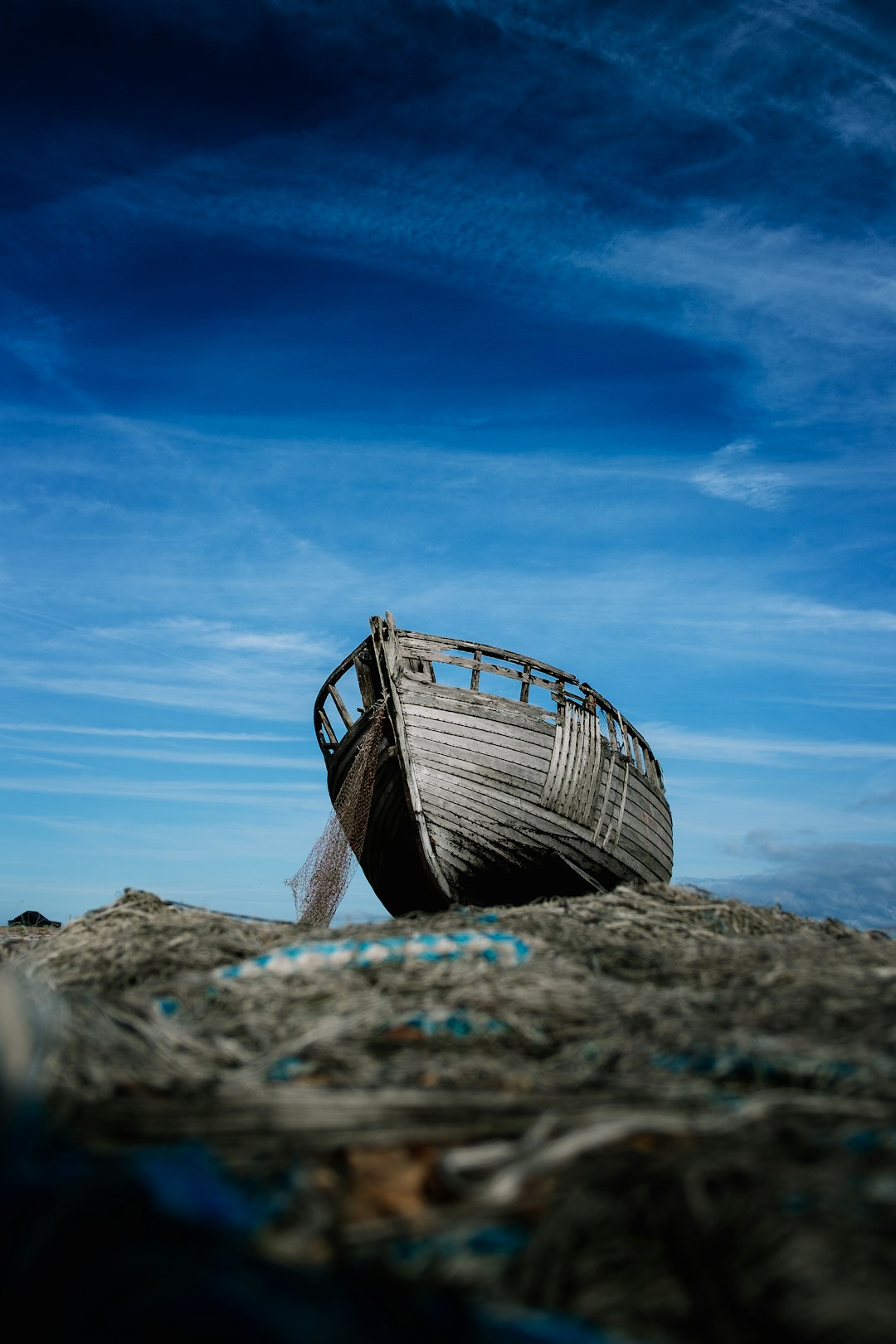
What are the most common injuries in hydrofoiling and how can they be prevented?
Common Injuries:
- Cuts and bruises from the sharp hydrofoil wings
- Head injuries from falls or collisions
- Sprains or fractures from awkward landings
- Rope-related injuries like entanglement or rope burns
Prevention Tips:
- Always wear a helmet and impact-resistant life jacket.
- Use foot hooks to maintain control and reduce falls.
- Practice falling techniques—fall away from the board and foil to avoid cuts.
- Inspect your rope and gear for wear and tear before every session.
- Take lessons to improve balance and control, reducing the chance of falls.
How do I choose the right hydrofoil gear for my skill level and riding style?
Beginner:
- Choose a larger wing (around 150-210 sq in) for more lift and stability.
- Use a short mast (24″-30″) to handle chop and wakes easily.
- Opt for boards with foot hooks for better control and safer falls.
Intermediate to Advanced:
- Experiment with smaller wings for speed and agility.
- Longer masts (30″+) allow for higher speeds and smoother rides in flat water.
- Customize fuselage length based on your preferred turning radius.
Riding Style:
- Wakefoilers behind boats benefit from wings designed for slow to moderate speeds (~8-13 mph).
- Surf foilers might prefer wings optimized for maneuverability in waves.
What are the basic hand signals used for communication between the hydrofoil rider and the boat driver?
Essential Hand Signals:
- Thumbs up: Ready to start or continue.
- Thumbs down: Stop or slow down.
- Pointing left/right: Indicate direction changes.
- Waving hand: Emergency or need to stop immediately.
- Holding up hand flat: Slow down gradually.
Clear communication is vital since verbal cues are often drowned out by engine noise and wind. Both rider and captain should agree on signals before hitting the water.
What safety measures should I take when falling off a hydrofoil board to minimize injury and quickly get back on?
Falling Safely:
- Fall to the side, never forward or backward onto the foil.
- Keep your arms and legs clear of the foil wings to avoid cuts.
- Try to relax your body to reduce impact force.
Getting Back On:
- Signal the captain to slow down or stop.
- Approach the board from the side opposite the foil.
- Use the rope or foot hooks to stabilize yourself before standing up.
- Always check your gear for damage before continuing.
Reference Links and Trusted Sources for Hydrofoiling Safety 📖
- United States Coast Guard – Boating Safety
- National Safety Council – Water Sports Safety
- O’Neill Official Website
- Troy Lee Designs Official Website
- Ronix Official Website
- How to Easily Wakefoil Behind the Boat – Hydrofoil Beginner Guide
- Hydrofoiling.org – Hydrofoiling Behind a Boat
- Hydrofoil Basics
- Hydrofoil Equipment Reviews
- Advanced Hydrofoiling Techniques
- Hydrofoil History
- Hydrofoil Board Selection

